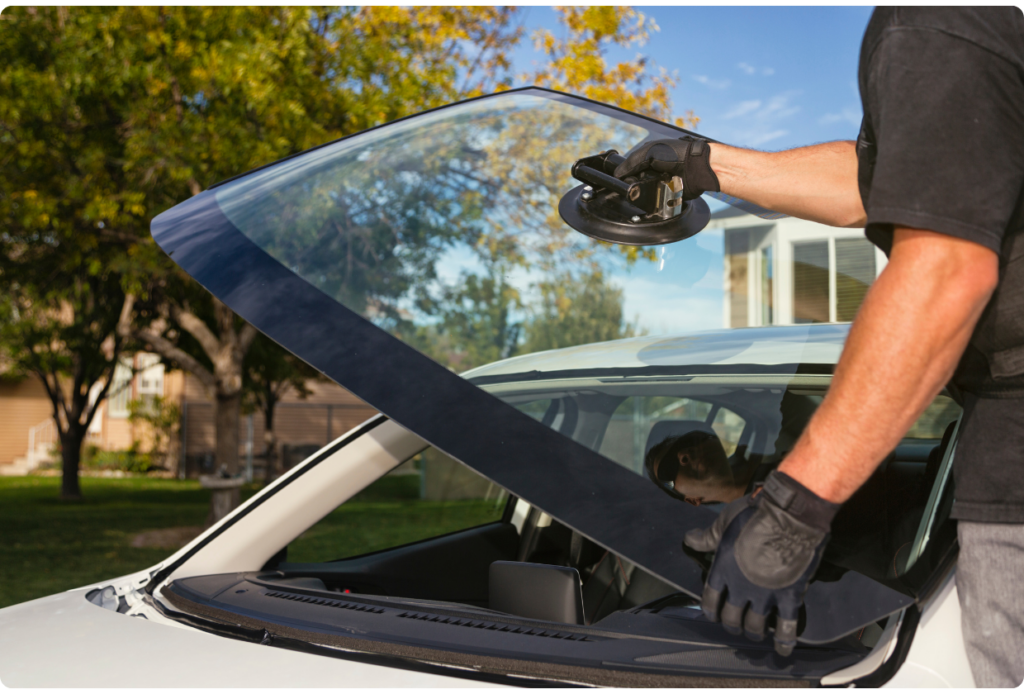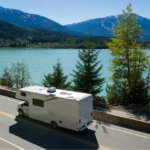Windshield damage comes in all shapes and sizes. Whether it’s a tiny chip caused by pebbles kicked up by passing trucks or a small crack that appears out of nowhere and keeps growing, these issues can lead to costly windshield repair or replacement.
While small windshield chips aren’t particularly dangerous, some can spread into spiderweb cracks and weaken your windshield’s structural integrity, making it more susceptible to future damage. Even small flaws can interfere with your wipers and make it harder to see the road, raising the risk of a potential fender-bender — or worse.
Read on to learn if a chipped or cracked windshield is covered by car insurance. Oh, and spoiler alert: the advanced technology packed into newer car models adds a whole new factor to the decision to repair or replace a cracked windshield.
Is it safe to drive with a cracked windshield?
It’s not just a matter of “Can you drive with a cracked windshield?” but whether you should. The answer depends on the size and location of the crack or chip.
Driving with a cracked windshield isn’t just a minor inconvenience—it’s a safety hazard. Let’s start with visibility. If you’re driving in bad weather or low-light situations, impaired visibility increases the chances of accidents, putting both you and other drivers at risk.
Even worse, if you’re driving with a cracked windshield, its ability to withstand impacts is significantly reduced, increasing the risk of shattering in an accident. Over a week or two, small cracks can spread due to temperature fluctuations and driving vibrations, further weakening the glass.
How bad can it get? In the event of a rollover accident, a damaged windshield may not support the vehicle’s roof, increasing the risk of severe injuries or fatalities. Addressing windshield damage sooner rather than later is the right thing to do for the safety of everyone on the road.
Is it illegal to drive with a cracked windshield?
While a police cruiser might not notice a small chip or crack in your windshield, drivers can receive tickets for damaged auto glass.
Violating state laws related to windshield safety standards can result in penalties ranging from fines to citations, which could impact insurance rates down the road.
Some states are lenient about minor windshield damage that doesn’t impair the driver’s view or compromise safety, while others require immediate repair or replacement to meet safety standards. Since regulations vary by state, it’s important to know the laws where you live.
If you plan to drive out of state, consider repairing or replacing a damaged windshield beforehand. Federal law prohibits driving with a windshield crack or chip larger than 3/4 inch in diameter, two cracks within three inches of each other, cracks that intersect, or cracks directly in the driver’s view.
Does car insurance cover windshield replacement?
Many car insurance providers offer extra coverage options for windshield repairs and replacements as part of their comprehensive policies, often for just a few extra dollars per month. This coverage can be a lifesaver if your auto glass gets damaged by flying debris, falling objects, or hail. However, keep in mind that coverage terms and deductible requirements can vary based on your specific policy and state regulations.
Sometimes, insurance will cover minor chip or crack repairs without touching your deductible. This proactive approach encourages car owners to get repairs made early, which in turn will help cut down on accidents and claims. It’s a win-win for the driver and the insurer.
On the other hand, if your windshield needs replacement, you might have to first pay a deductible before insurance kicks in. Understanding how auto insurance deductibles work in these situations is key.
So, if your windshield gets damaged, take a moment to review your car insurance policy to understand how it handles glass coverage and the claims process. Additionally, before deciding to pay for auto glass repair out of pocket, it’s worth checking the regulations governing windshield damage in your state—there may be local laws for mandatory coverage at no cost.

Can you fix your own windshield?
While common windshield chips may not win any beauty contests, they rarely cause significant damage to a vehicle’s inner glass layers. Many of these chips can be addressed with an inexpensive do-it-yourself windshield repair kit, readily available online or at an auto parts store.
Typical kits include all the necessary tools for patching small dings, including epoxy and resin, applicators, suction cups, and a scraper for easy cleanup. The entire project usually takes under two hours, with curing taking the most time.
While repairs are relatively straightforward, even for beginners, there are limits to what amateur auto glass repair can accomplish. Be aware that cracks near windshield wipers almost always re-crack, and DIY repairs may not be suitable for damage near the edges or in the driver’s line of sight.
Keep in mind that if you botch the repair, there’s no do-over. Improperly performed repairs can make things worse, and attempting to repair a windshield yourself could void your vehicle warranty. Plus, if faulty DIY glass repair leads to further damage or personal injuries, your insurance might not cover you.
When to repair vs. replace your windshield
Repairs are typically less expensive than replacements, especially if covered by insurance or if the damage is minor. Deciding whether to repair or replace your windshield depends on several factors. Here’s a guide to help you make the right decision:
When to repair a cracked windshield
- Size of Damage: If the damage is small, such as a chip that’s less than an inch in diameter or a crack less than three inches in length, it can usually be repaired.
- Location of Damage: Chips or cracks that are not in the driver’s line of sight, within the size limits described above, and are away from wipers and the edges of the windshield are more likely to be repairable.
- Type of Damage: Surface-level damage that hasn’t penetrated through the entire glass layer is often repairable.
When to replace a cracked windshield
- Extent of Damage: If the damage is extensive — such as cracks three inches or more in length, more than one crack within inches of each other, spiderweb cracks, or multiple chips — replacement may be necessary.
- Location of Damage: Evaluate how the damage affects visibility. If it obstructs the driver’s line of sight or is near the wipers or edges of the windshield, it may require replacement.
- Safety Concerns: If the structural integrity of the windshield is compromised or if the damage affects the deployment of airbags, replacement is required for the safe operation of the car.
Other factors to consider
- Regulations: Some states have laws dictating when a windshield must be replaced rather than repaired. Check with your insurance provider.
- Insurance Coverage: Review your insurance policy to determine coverage for windshield repairs and replacements. Understand your deductible and coverage limits.
- Professional Assessment: When in doubt, seek the advice of a professional auto glass technician who can assess the damage and recommend the best course of action.
Finding a balance between costs and vehicle condition
When deciding whether to repair or replace your windshield, safety should be your first priority. But you’ll also want to consider your car’s condition, your budget, and your plans for the future.
If you’re planning to hang onto your car for a while and it’s still in good shape, getting a new windshield might be the way to go. It’ll keep you safe on the road and ensure your car stays in top-notch condition.
On the flip side, if your car’s seen better days or you’re thinking about trading it in, a repair could be a more practical choice. It’ll save you some cash and get you back on the road without breaking the bank. There’s no one-size-fits-all answer, but here are some parameters to help you make a decision.
How much does it cost to repair a windshield?
- According to AAA, the typical cost of repairing a single chip in your auto glass is between $60 and $100.
- Discounts may apply for repairing multiple chips on the same windshield.
- Repairing longer cracks may cost $125 or more, depending on the technique and complexity of the damage.
How much does it cost to replace a windshield?
- Costs vary based on vehicle type, glass quality, labor expenses, and whether or not they’re high-tech or low-tech.
- The average windshield replacement cost ranges from $300 to $600 for older vehicles with standard glass.
- Newer vehicles with advanced safety features may need replacements that cost over $1,000.
Should I replace a windshield in an older car?
If your car has a few miles under its belt but is still running smoothly, opting for a repair instead of a replacement could be a smart move, especially for minor damage. This is particularly true if your car has sentimental value or if you plan to keep it for the long haul.
However, if your windshield has taken a real beating and needs a full replacement, it’s time to consider the costs. With older cars, the cost of replacing the windshield could end up being more than the car itself is worth. So, if your wheels have seen better days, you might want to consider selling or trading it in rather than investing any more money into it.
What about replacing a windshield in a newer car?
Advanced Driver-Assistance Systems (ADAS) features — like lane departure warnings, forward collision alerts, and adaptive cruise control — are becoming increasingly standard in modern cars. Because ADAS features use sensors and cameras built into the windshield, fixing or replacing them becomes a bit trickier and much pricier.
When auto glass work is done on ADAS-equipped cars, these sensors will need to be recalibrated with specialized equipment and expertise. Improper handling can impact their performance and potentially compromise overall safety when operating the vehicle. Owners should take this into account when speaking with their insurers to figure out how best to mitigate these expenses.
All-around protection for what matters most.
We’ve covered the big decision of repairing or replacing a cracked or broken windshield. We’ve talked about safety, the law, insurance, DIY fixes, expenses, and what factors to consider when making the call. Most importantly, we’ve stressed why it’s important to act fast to keep things safe on the road.
We’ve also looked at car insurance coverage, giving you a heads-up on what to expect. If you’d like to add auto glass coverage to your current policy or find a new policy that offers full windshield protection, the auto experts at Guided Solutions can certainly give you a hand with that.
In addition to car insurance, we offer motorcycle and boat coverage, and property insurance, too. There’s also life insurance, Medicare, health insurance, and business coverage.
Our friendly team is here to help you find the perfect coverage that fits your needs, all at the best rates available. And guess what? It won’t cost you a thing to get a quote, and there’s no pressure to make a purchase. It’s simply the smarter way to get insured.










